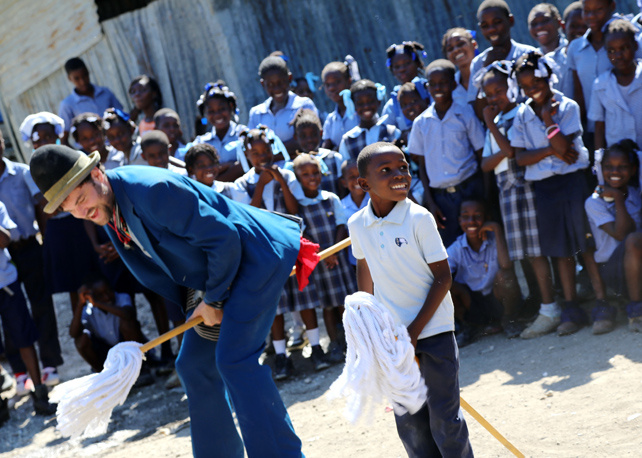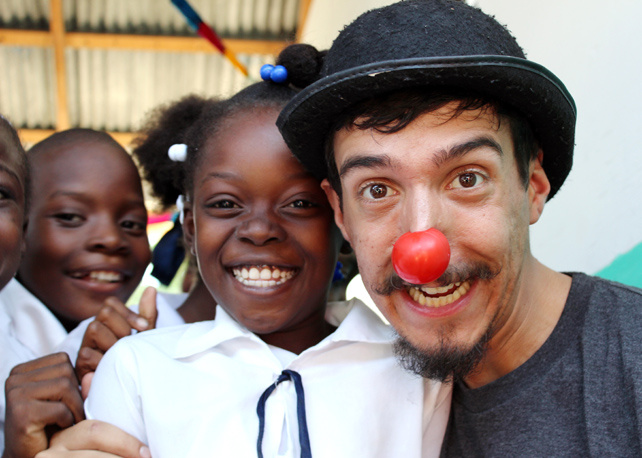.jpg)
Advertisement
.jpg)
Advertisement
.jpg)
David Lichtenstein: We try to target the neediest people in the world. And yeah, a lot of these places are dangerous. Some of them are dangerous for the boring things like transportation issues—problems with cars and roads. Although we have been in war zones, we haven’t been too close to heated war. Still, there is often random violence in those places.What are some of the most dangerous situations you’ve been in?
David: I’ve just been to Haiti, Guatemala, Palestine, and Chiapas, Mexico, during the [Zapatista uprisings].
Tim Cunningham: We’ve sent teams to work in Bhutanese refugee camps. I think [that we mainly ship clowns to] places that are proximal to war. In Colombia, we recently did a project along the Ecuador border and one of the towns we worked in was about 100 yards away from a FARC camp. But that [presence of violence] is in the background.
David: On that first trip to Chiapas, though, [Tim and another clown] were both robbed by Mexican police, or at least we thought they were police—we’ve been unable to find out whether they were real cops or thieves in uniforms. And during a show, Tim was lassoed by somebody and dragged by his feet on horseback. That was his first trip and he still came back for more.
Tim: I was hooked. I was like, This is real performance. This is engagement with my audience.
Advertisement
.jpg)
Tim: We were in a really rural area and he was known as the regional drunk. We were doing a slapstick piece where I was working with this other clown, this really beautiful, sweet performer. And you could tell from the beginning he had his eyes set on her. He followed everything she did and was laughing really loud. In the slapstick routine we hit each other with this newspaper. She takes it from me, hits me; I take it from her… we go back and forth. Really classic slapstick. I think he decided he needed to save her, so he let out a yell during the bit and reared back on his horse like the Lone Ranger. The crowd split and I guess I was too dumb to split with everybody else. I was like, Great, I’ve touched this guy. And he touched me with his lasso. And dragged me down the road.A lot of the places you go are very rural and have had little exposure to foreigners, much less to foreign clowns. Do you consider security risks when you travel? Like guys with lassos?
Tim: We go where we’re invited. If we have connections with other NGOs that have bases on the ground, that gives us some security. Or we have friends and family who are doing work in a place and know where we could do a show. We rarely say, “Hey guys, I think we should pack up and go to Ecuador this week and do clown work because we think it’s needed.” Haiti’s a good example of that. We’ve been working there since 2006 and wanted to go back down after the earthquake. As an organization we decided not to go until people started asking us to come. We didn’t think it was appropriate for us to go right after the catastrophe because people needed food, shelter, water… they needed life basics. We thought they would send for us six months, maybe a year later, but within a month of the earthquake we started getting calls.
Advertisement
.jpg)
Tim: A couple of years ago I got an email from a donor who was very upset with us for what we do. He said, “You’re going to these places and you’re not bringing food, you’re not bringing shoes… what are you doing?”And I wrote back and said, “Hey, I appreciate your email and if you want to support those groups, here is a list of them that are doing exactly what you say.” But we’ve also met people who have had their minds changed after they see us with the kids, and see what a space is like when we come in, and then the change that has happened when we leave.Is it trivial when you have people who are starving and have no medicine and you go in and clown for them? That’s a good question to ask. It’s a hard question and we certainly get a lot of pushback. We should, though. If everyone agrees with what you do, you’re probably doing something wrong.
David: As an aid group, we are a side dish. We come after medicine and water and food [aid] is underway. We’re also a volunteer-only organization. We just come in for a few weeks and do a few shows. We’re not affecting the economy. We’re doing ten major projects a year and a few small domestic projects on an annual budget of $40,000. We’re just a li’l guy in the aid world.
Advertisement

Tim: In Haiti in 2006 we were working in a small, rural community called Torbeck. The kids there loved us, and one night when I was exhausted after a long day I suddenly felt this weight on my back. Before I could figure out what was going on this kid was standing on my shoulders. It was this clear night and we were looking up at the moon and I said, “Hey, hey, Jo-Jo, you and I, we’re going to go climb up to the moon.” And he laughed and looked down at me and said, “No no no, nous manger la lune [we’re going to eat the moon].”So during this imaginary game it struck me that this kid was really malnourished. He was constantly asking us for food, but after the show and while playing with us he still had this fire of imagination that every kid in the world is capable of having. And to see his imagination explode like that just showed some really amazing resilience. I think we see that resilience with kids all over the world.

David: One of the fun things for us as performers is that we get to work on a very basic, elemental version of clowning. In the US, maybe people would want something more sophisticated, but basic clowning generally works everywhere.
Tim: For example, we’ve got a bit that involves a clown finding a balloon. The clown finds the balloon, picks it up, stretches it out, slaps himself in the face by accident, and tries to blow it up. He’s not able to do it and we do all these funny things trying to figure out how to blow up the balloon. Then the bit ends with the clowns bringing a child up on stage. One of the clowns is holding the balloon in his mouth and his arm is out to the side making a half-T shape. The kid pumps his arm up and down, and that blows up the balloon. So the kid keeps pumping the arm and everyone’s laughing, but then the balloon pops. All of the clowns look at these balloon shards that are on the ground and they start crying and bawling and we have this balloon funeral.
Advertisement

David: In Palestine last week we developed a little checkpoint clown piece, and that worked really well there because checkpoints are a part of their daily life—not being let through, not being let out. When we started the checkpoint clowning the crowd just went quiet, but then they would laugh at the gags. Also, it’s a Muslim area and we were a mixed male and female group of clowns, as usual. We had prepared for a Muslim audience, though. We took out a lot of touching and a couple of parts where there was hip-swinging dancing because we wanted to be safe. But then we wound up putting a lot of that back in because we realized that clowns can get away with breaking the rules. It’s OK for a male and female clown to touch each other, to bang into each other or whatever, in slapstick. Clowns have different rules.
Advertisement
David: Making fun of life is a pretty universal phenomenon. I watched a video of a Brazilian clowning troupe that went into the Amazon jungle to clown for an indigenous group. The locals had a guy who was like a clown, who made his living just going around being silly and making fun of the daily tasks that everybody else did, and the clown troupe just went in and improvised with this guy.Speaking of universal, have you ever had any issues with coulrophobia, the fear of clowns that’s such a trope in the West, during your travels?
David: It’s the big white face and clown costume that sets it off. We’re in fairly normal costumes—goofy clothes but natural faces, with perhaps a clown nose.Tim: In Haiti we had a clown who wore stilts. We opened the show and the kids were cheering, but as soon as the clown on stilts came around the corner they freaked out—everyone was crying and trying to back away. So the clown kind of eased off and we quieted down the music. She got the stilts off in a really funny way. Then, after about three or four minutes, they were back to sitting there, laughing with us. So there was a fear of this big thing, but I wouldn’t call it a fear of clowns.
.jpg)
Tim: There is not a lot of evidence out there at all. People have explored clowns in hospitals and done somewhat rigorous studies looking at the benefits of stress relief for preoperative patients, as well as reducing the stress of doctors and nurses in some cases. But really very little has been done examining what Clowns Without Borders does in refugee camps, conflict zones, and zones in crisis.There was one study where they were saying, I guess, that you can increase your chance of success with in vitro fertilization if you’re entertained by a clown while they’re doing the IVF. People say you’re less stressed and your body is more accepting of what’s going on.Well, that’s an image.
Tim: Yeah, I don’t think I’d want to be watching a clown whileI… but I guess they’ll never do that to me.What I’d like to see, though, is if you’d have lower levels of stress in conflict zones. I’d guess there might be better community adherence. We know that using performing arts and art therapy is a whole other way for people to work with psychological trauma and find creative spaces to do something positive. I’d like to build a body of evidence that shows that. Or doesn’t show that. Who knows? Maybe what we’re doing isn’t right. That should be examined as well.
.jpg)
